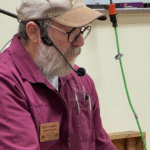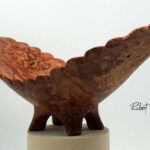About Front Range Woodturners
 We are the Denver area chapter of the AAW (American Association of Woodturners) serving woodturners throughout Colorado’s Front Range.
We are the Denver area chapter of the AAW (American Association of Woodturners) serving woodturners throughout Colorado’s Front Range.
Our Meetings
We meet on the first Tuesday of every month from 6:15 PM to 9:00 PM in the basement of Rockler Woodworking and Hardware, 2553 S Colorado Blvd, Denver, 80222.
Visitors are welcome to join us at one of our meetings to see what we are all about.
Upcoming Demonstrations
Jan – Bob Franklin – Winged Bowl

 Growing up in New Mexico, Bob has been involved in some form of woodworking since he was a teenager. He moved to Colorado in 1989 for work. Around 2009, Bob picked up an old 1930s lathe at a garage sale, refurbished it, and began learning how to turn.
Growing up in New Mexico, Bob has been involved in some form of woodworking since he was a teenager. He moved to Colorado in 1989 for work. Around 2009, Bob picked up an old 1930s lathe at a garage sale, refurbished it, and began learning how to turn.
Over the next few years, in his off time, he slowly taught himself. With the help of YouTube and extensive research, he truly fell in love with woodturning. A few years later, he discovered there were two local woodturning clubs—Rocky Mountain Woodturners and Front Range Woodturners—as well as a pen club, Pens Plus, all within 45 minutes of his home. He joined all three and has been a member ever since. He has served as the EOG Chair for Front Range Woodturners and as President of the Rocky Mountain Woodturners.
Bob and his wife, Cindy, also fell in love with resin casting and made and sold thousands of hybrid blanks to woodturners all over the world. Over the course of about five years, their blanks could be found at the local Woodcraft in Loveland and were also available online at turnerswarehouse.com and ringsupplies.com. While this was a thriving business, a few years ago the Franklins stopped making blanks to refocus on woodturning as a hobby.
Bob has demonstrated for all three clubs on multiple occasions and has also been a regional demonstrator at the Rocky Mountain Woodturning Symposium on a variety of topics. He works out of a small shop on the lower level of his townhome in Thornton, Colorado.
In this demonstration, Bob will show how he creates winged bowls with carved feet. He was inspired to make these after watching several turners create them and has since developed his own method for producing these fun and distinctive bowls, which he will share during the demo.
In addition to seeing his work at monthly meetings, you can also find it on Instagram at:
https://www.instagram.com/franklinscreativecorner/
Feb – Don Prorak – Square to Round Hollowed Box with a Spinning Top Lid
Demonstrators for 2026:
Mar – Kalia Kliban – Milk Paint or Porringers https://kaliakliban.com/woodworking/
Apr – Pat Carroll (from Ireland)
May –
Jun –
Jul –
Aug – Michael Anderson – Spin Top on Coin Bearing
Sep –
Oct – J.Paul Fennel
Nov –
Dec – Holiday Party
Member Benefits
- Library – The Front Range Woodturners has an extensive collection of books, magazines, and videos available for members to check out at no cost.
- Demonstrations – Monthly meetings feature an exciting demo given by one of our club members or a professional turner. When available we also offer a full day hands-on class with these renowned turners at a nominal cost.
- Brown Bag Demo – Bring your lunch and watch a free in-person mini demo on a variety of topics in a smaller, more relaxed setting.
- Wood Drawing – Members can bring some of their excess (good) wood to a meeting so it can find a new home with a different member. You can never have too much wood!
- Group Buy – Do you want to save money? We have vendor discounts with Internet suppliers, local suppliers, tool and steel suppliers and wood suppliers. Through our deals with these vendors our members can easily earn back the cost of membership!
- Ladies of the Lathe – All female members of the FRW, aged 18 or older, are invited to join the Ladies of the Lathe. LOTL is intended to provide a comfortable, easy-paced, and non-threatening environment for women to learn and advance their skills in turning.
- Mentoring – Members have access to several programs to help increase their woodturning skills. Group sessions are held monthly and one-on-one mentoring on various topics can be arranged with experienced FRW volunteers.
- PHEOG – The Pete Holtus Educational Opportunity Grant program provides grant money to members through an application process. Applicants may request money for woodturning related classes, workshops, or symposium fees.
- Workshop Tours – monthly tour of members workshop. Get ideas and get inspired!

Special Notices
2026 Officer and Chair positions have been voted on and accepted. Thank you to everyone who volunteers and continues serving in Board and Chair roles! Your time and effort keep our woodturning club spinning strong — we appreciate all you do.
- The FORMS tab (above) has all of our forms in one spot (Group Buy, Membership, Gallery, etc).
- The Turning Challenge for the January 2026 meeting is a Sphere, or anything with a Sphere.
- Our next Brown Bag Demo (“view and chew” as Raleigh says) is on January 13th. Raleigh Lockhart will demo and lead a discussion on Laser Engraving Demonstration & Best Practice Sharing.
Have you ever considered getting a laser engraver? If the answer is yes, or even “maybe,” this demonstration is for you. Whether you’re curious about buying one or already own a laser, come ready to learn, share your tips, and ask questions!
*Raleigh will demonstrate his small, portable laser engraver.
*Share his process for building engraving graphics.
*Lead a Group Best Practice Sharing discussion.
- Our next Group Buy is the January 2026 meeting with pickup at the February meeting. Group Buys are once a quarter (Jan, Apr, Jul, Oct).
- Membership Renewal: Use our online form if you want to pay with credit card or PayPal. If you want to pay with check you can fill out an eForm and mail it or bring to a meeting. Click on FRW Membership Info (top of the Home page), or the Forms tab and fill out the Current Member Renewal Online Form.
- PHEOG Grant. Congratulations to the 2025 grant winners!
Marcee Morris
Don Sheffield
Brenda Blaesing
Rocky Mountain Folk School
(c/o Dennis Fanning)
Remember if you received an award you have 1 year to give your payback to the club.
Upcoming Events
- FRW Holiday Party
See you at our annual Holiday Party!
When: Dec. 12th
Deadline to sign up: Dec. 5th
A SignUpGenius link has been emailed to members.
2026 Symposiums
 American Association of Woodturners 40th International Woodturning Symposium
American Association of Woodturners 40th International Woodturning SymposiumJune 4 – 7, 2026
Raleigh Convention Center
Raleigh, NC
www.woodturner.org
www.aawsymposium.org Rocky Mountain Woodturning Symposium
Rocky Mountain Woodturning Symposium
What a great Symposium! Mark your calendars for next year:
September 18-20, 2026
Loveland, CO
rmwoodturningsymposium.com/
